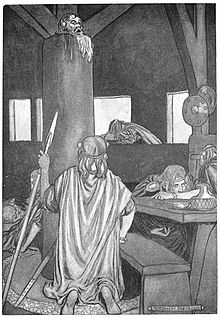Sualtam
Súaltam , also Súaltaim , Súaldam , Súaldaim , Súaltach , with the patronymic mac Róich [ 'suaLtivʼ mak Roiç ], is the name of a legendary figure from the Táin Bó Cuailnge ("The cattle robbery of Cooley ") in the Ulster cycle of the Celtic mythology of Ireland .
Lore
In the Remscéla ("prehistory") of the Táin Bó Cuailnge , Compert Con Chulainn ("Cú Chulainn's conception"), Deichtire , the daughter (or sister) of Conchobhar Mac Nessa , stays for one night in a farm where the god Lugh with her is sleeping. The child resulting from this connection is the later Ulter-Hero Cú Chulainn . Another version of the pregnancy is said to have come about by swallowing a small animal, and Conchobhar's incest with his daughter is also reported. Conchobhar then wed his daughter to Sualtam, the son of an elf. The boy is raised by Deichtire's sister Finncháem and is initially given the name Sétanta mac Sualtaim. So Sualtam becomes the mortal father of Cu Chulainn, Lugh the divine.
When after 17 years of Connacht a war against Ulster begins under the royal couple Medb and Ailill mac Máta , the weakness imposed by Macha as punishment attacks the Ulter warriors ( Noínden Ulad ), so that Cú Chulainn and his father Sualtam are alone at a ford for the time being enemy troops on the border at Iraird Cuilenn (Crossakiel, County Meath ) have to fend off. Sualtam rushes to the royal court of Conchobhar in Emain Macha to get help - for reasons that are not known to us, Sualtam needs a few months. He storms into the hall and shouts out his warning. But since it is a geis (“taboo, prohibition”) to speak before three druids and then the king have spoken, he should be executed. Therefore, they want to arrest him without paying attention to his words, but he flees. When Sualtam stumbles in front of the hall, he falls against the edge of his shield, which cuts off his head. In one version he turns his horse around so violently that misfortune happens. On the sign, his head is brought back into the hall, where he continues to shout his warning non-stop. Now Conchobhar finally recognizes the danger and comes to the aid of Cú Chulainn with his quickly summoned warriors.
See also
literature
- Helmut Birkhan : Celts. Attempt at a complete representation of their culture. Publishing house of the Austrian Academy of Sciences, Vienna 1997, ISBN 3-7001-2609-3 .
- Ingeborg Clarus : Celtic Myths. Man and his otherworld. Walter Verlag 1991, ppb edition Patmos Verlag, Düsseldorf, 2000, 2nd edition, ISBN 3-491-69109-5 .
- Bernhard Maier : Lexicon of Celtic Religion and Culture (= Kröner's pocket edition . Volume 466). Kröner, Stuttgart 1994, ISBN 3-520-46601-5 .
